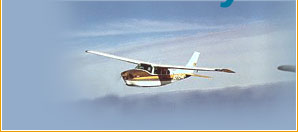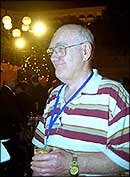The Rediff Special/ Basharat Peer


You see the rainbow and think: what can be more colourful?
Lucky were the ones at Delhi's Indira Gandhi international airport on Wednesday. They saw something more colourful, more spectacular:
A fleet of 40-odd machines, participants in the first London-Sydney Air Race of the century.
They had started out from England's famed World War II fighter station at Biggin Hill in Kent. To reach Sydney, they will take what's known as the Kangaroo Route, flying 22,000 air kilometres, much of it over inhospitable terrain.
The London Sydney Air Race 2001 shares the tradition of two of aviation's most significant events: the England Australia Air Races 1919 and 1934.
The 1919 race originated with an offer of 10,000 pounds by the Australian government to the first of its sons to fly home from England. It attracted a great deal of interest from World War I aviators.
Brothers Ross and Keith Smith, in a Vickers Vicky bomber, claimed the prize. They completed the journey in 28 days; leaving London on November 12, 1919, they arrived at Darwin on December 10.
The fact that it took two other contestants, Ray Parer and John McIntosh, over nine months to get home is a tribute to the Smiths.
The 1934 air race, dubbed The Great Race, attracted an array of aviation pioneers flying a variety of aircraft, from small machines to Royal Dutch Airlines Doughlas DC2, the forerunner of the famous DC3.
Victory kissed Britain's C W Scott and Campbell Black. Their twin-engine Comet reached Melbourne in 71 hours.
The Great Race had its moments of drama. For instance, a violent electric storm forced the DC2 to make an emergency landing at night at Albury, just a few hours short of Melbourne. In a classic piece of flying, the pilot landed on a racecourse, helped by car headlights.
Such is the legacy of the London-Sydney Air Race 2001. And the fliers ensure that they live up to it.
A mother plane flies with the participants. It is equipped with sophisticated communication and medical facilities.
TIM Elison, a former Royal Air Force pilot, is the winner of the Delhi leg of the race.
 During his airforce days, on a routine flight in May 1992, Elison's plane crashed. He survived, but had to spend a year in the hospital.
During his airforce days, on a routine flight in May 1992, Elison's plane crashed. He survived, but had to spend a year in the hospital.
He left the hospital in a wheelchair. And the RAF closed its doors on him.
"But I found a country that said yes to me: America. So I left for the USA and after some more training I was back in a cockpit," he tells you. "I flew there for years before returning home."
"Then the British Airways Authority took me seriously and allowed me to fly in England. It was the first time in England that a paraplegic pilot was allowed," he adds.
Elison's crusade did not stop there. He fought to make his exception a rule. "I kept arguing that they should allow the disabled to fly. Finally I succeeded in convincing them," he says.
In 2000, England amended its laws to allow people with disabilities to fly.
What is it that prompted him to participate in this race? "The adventure and the lifetime opportunity to be part of this historical race," Elison answers. "Also, I wanted to tell the disabled of the world that we can do it, it is all in the mind."
Elison is co-piloting a Beechcraft with friend Mark Wilkinson. "I am very excited. Having won the Delhi leg, I feel on the top of the world," he says.
"I felt I was the king of the world when my machine left the runway at Bigin Hill," says Russel L Wilson, a 71-year-old American. He is in one of the oldest planes in the race, a 1948 Grumman Albatross amphibian.
Wilson, a fundraiser from Iowa State University, USA, is flying with his friend Lyle Campbell. His three daughters, son and four grandchildren are thrilled at his participation.
"My children were emphatic that I should go for it. I got to see 12 countries in 12 days! Everywhere people gave us great reception! It shows the beauty of human nature," Wilson beams.
He cannot forget his experience in Kuwait. The American Navy hosted a reception for the fliers on aircraft carrier Harry S Truman.
"It was a sight to see fighters take off and land on the ship," Wilson adds, a trifle dreamily.
 AUSTRALIAN Murray Rowley is all charged up as the race is part of the centenary celebrations of the Australian Federation. A chartered accountant, he took up flying because his job required him to rush to various places at short notice.
AUSTRALIAN Murray Rowley is all charged up as the race is part of the centenary celebrations of the Australian Federation. A chartered accountant, he took up flying because his job required him to rush to various places at short notice.
"I live in Gold Coast, the second-last stop of the air race. I could not bear to see the others land there without being one of them," says Rowley. "I may not win the race, but it is a great experience."
Flying a Cessna 210, Virginia Wykes, an aboriginal, is out to encourage her people to take up flying. A farmer from New South Wales, she started flying in 1982 because her pieces of property were too distant to travel by road.
"This is an opportunity of a lifetime," she says. "No aboriginal Australians had taken it up."
There is one thing that Wykes, like the other fliers in the team, would love to see in India: Taj Mahal. Unfortunately, the monument of love remains closed on their only free day here.
How is it to fly off into the yonder come the morrow? "It is like a dream," she says. "I pinch myself at times to believe it is for real."
Photographs of Elison and Rowley: Sondeep Shankar
Design: Dominic Xavier
The Rediff Specials